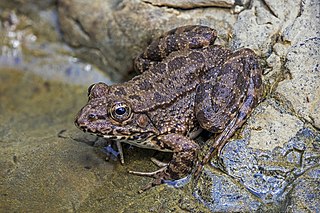
True frogs is the common name for the frog family Ranidae. They have the widest distribution of any frog family. They are abundant throughout most of the world, occurring on all continents except Antarctica. The true frogs are present in North America, northern South America, Europe, Africa, and Asia. The Asian range extends across the East Indies to New Guinea and a single species, the Australian wood frog, has spread into the far north of Australia.

Meristogenys is a genus of true frogs from Borneo. Its tadpoles are adapted to fast-flowing mountain streams and easily recognizable by their divided upper lip with ribs on the outside.

Indosylvirana aurantiaca, commonly known as the golden frog, is a species of frog endemic to the Western Ghats of India. The species is also known as the Trivandrum frog, the common wood frog, or the small wood frog.
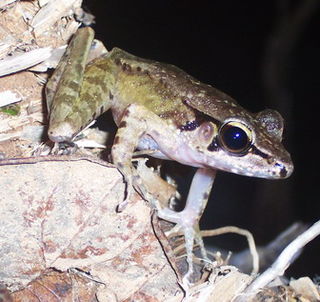
Torrent frogs are a number of unrelated frogs that prefer to inhabit small rapid-flowing mountain or hill streams with a lot of torrents. They are generally smallish neobatrachians with a greyish-brown and usually darkly mottled back, giving them excellent camouflage among wet rocks overgrown with algae; their well-developed feet make them agile climbers of slippery rocks.

The Petropedetidae are a family of frogs containing three genera and 12 species. They are found in sub-Saharan tropical Africa and are sometimes known under common name African torrent frogs.
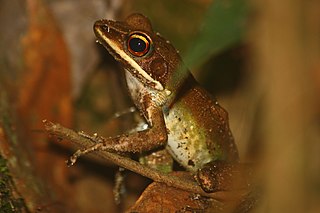
Amnirana albolabris is a species of frog in the family Ranidae. It is widely distributed in Sub-Saharan West and Middle Africa. However, the nominal species includes at least one undescribed species west of Benin; the formal taxonomic changes to split the species have not yet been done. Common names white-lipped frog and forest white-lipped frog has been coined for it, whereas Bamileke Plateau frog refers to now-synonymized Amnirana longipes.

Amnirana lepus is a species of frog in the family Ranidae. It is found in Cameroon, Equatorial Guinea, Gabon, Central African Republic, Republic of the Congo, Democratic Republic of the Congo, and northern Angola. Common names Andersson's Cameroon frog, Andersson's white-lipped frog, and jumping white-lipped frog have been proposed for it.
"Hylarana" chitwanensis is a species of frog in the family Ranidae endemic to Nepal. Its type locality is in the Chitwan National Park. Earlier reports from India are erroneous although it is likely to occur there.

Pelophylax is a genus of true frogs widespread in Eurasia, with a few species ranging into northern Africa. This genus was erected by Leopold Fitzinger in 1843 to accommodate the green frogs of the Old World, which he considered distinct from the brown pond frogs of Carl Linnaeus' genus Rana.

Hylarana, commonly known as golden-backed frogs, is a genus of true frogs found in tropical Asia. It was formerly considered highly diverse, containing around 84 to 96 valid species, but taxonomic revision resulted in a major change in the contents of the genus, and today it is recognised as containing just four species.

Sylvirana is a genus of true frogs, family Ranidae, found in South and East Asia, from northeastern India in west to China in the north, Taiwan in the east, and Thailand in the south. Originally proposed as a subgenus of Rana in 1992, it has been considered both a full genus and a synonym of Hylarana. Its current recognition at generic level stems from molecular genetic analyses published in 2015.
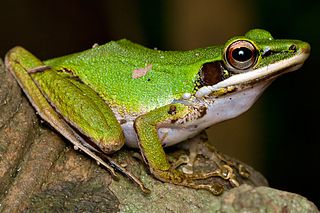
Chalcorana is a genus of frogs in the family Ranidae, "true frogs". They are found in Southeast Asia, from Thailand to Malay Peninsula and the Sunda Islands.

Papurana is a genus of frogs in the family Ranidae, "true frogs". They are known from Southeast Asia, New Guinea, and northern Australia. Papurana daemeli is the only ranid frog found in Australia.
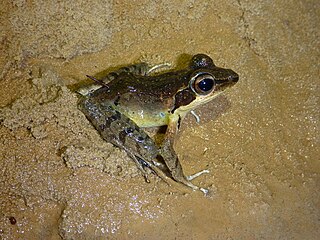
Papurana elberti is a species of true frog. It is native to Indonesia and Timor-Leste and found on the islands of Timor and Wetar. The specific name elberti honours Johannes Elbert, a German naturalist who joined an expedition to the Lesser Sunda Islands and Sulawesi in 1910. Common name Lesser Sundas frog has been coined for it.

Papurana florensis is a species of true frog. It is native to the islands of Lombok, Sumbawa, and Flores in Indonesia. Common names Floresian frog and Flores frog have been coined for it.

Papurana moluccana is a species of true frog. It is endemic to the Maluku Islands of Indonesia; specifically, it is known from Halmahera and Bacan. Common name Moluccas frog has been coined for it.

Papurana papua is a species of true frog, family Ranidae. It is endemic to New Guinea and found in the northern part of the island in both Indonesia and Papua New Guinea as well in some offshore islands. Common name Papua frog has been coined for it.

Odontobatrachus is a genus of frogs comprising the family Odontobatrachidae. In a 2014 research project Barej, Rödel, Loader & Schmitz separated the genus from the established genus Petropedetes and separated the new family from the established family Petropedetidae.

Abavorana is a genus of true frogs found in Southeast Asia, namely the Malay Peninsula, Sumatra, and Borneo. Species in this genus were formerly classified in the genus Hylarana, but were reclassified into the new genus Abavorana following a 2015 phylogenetic revision of Hylarana.

















